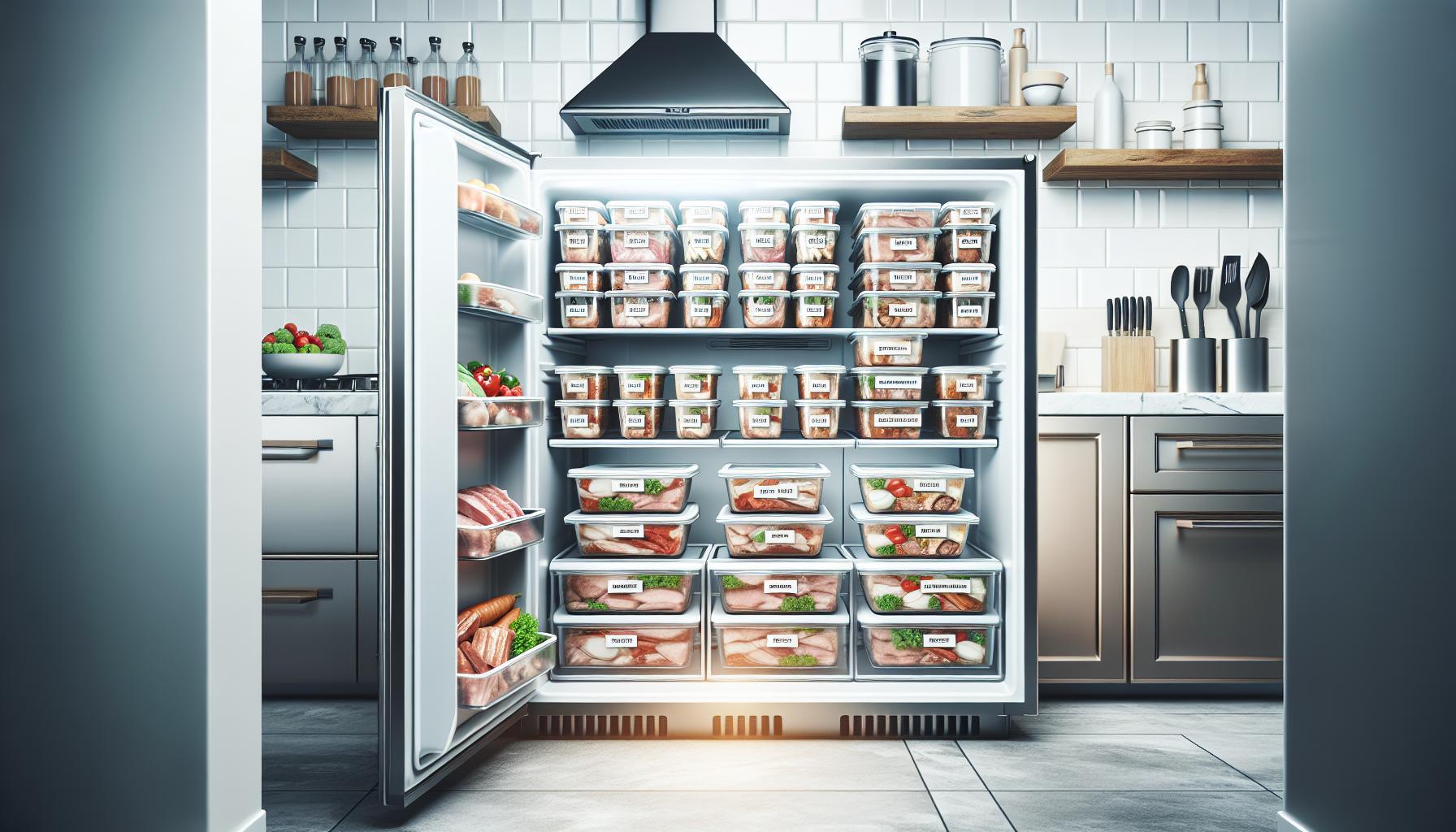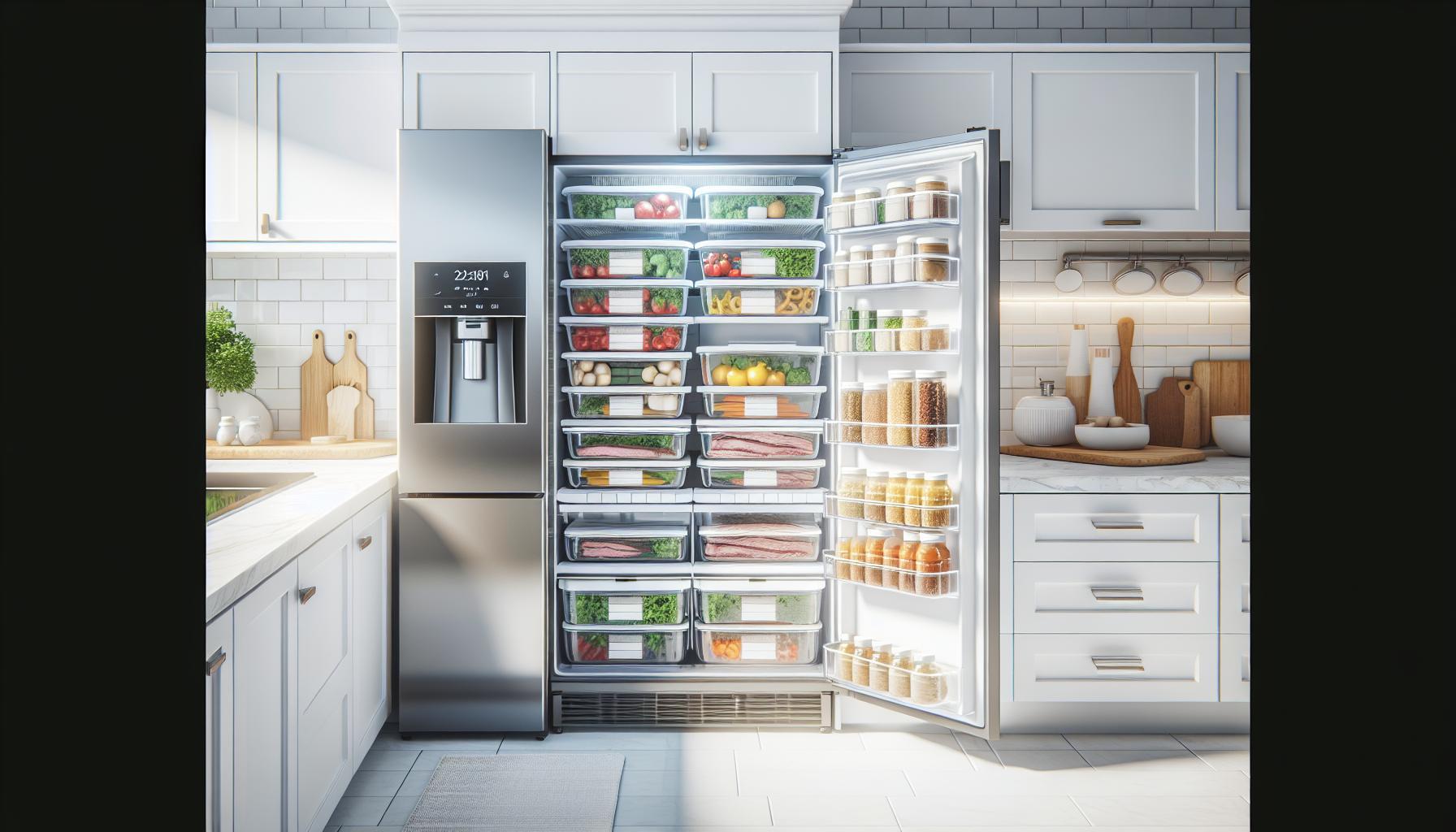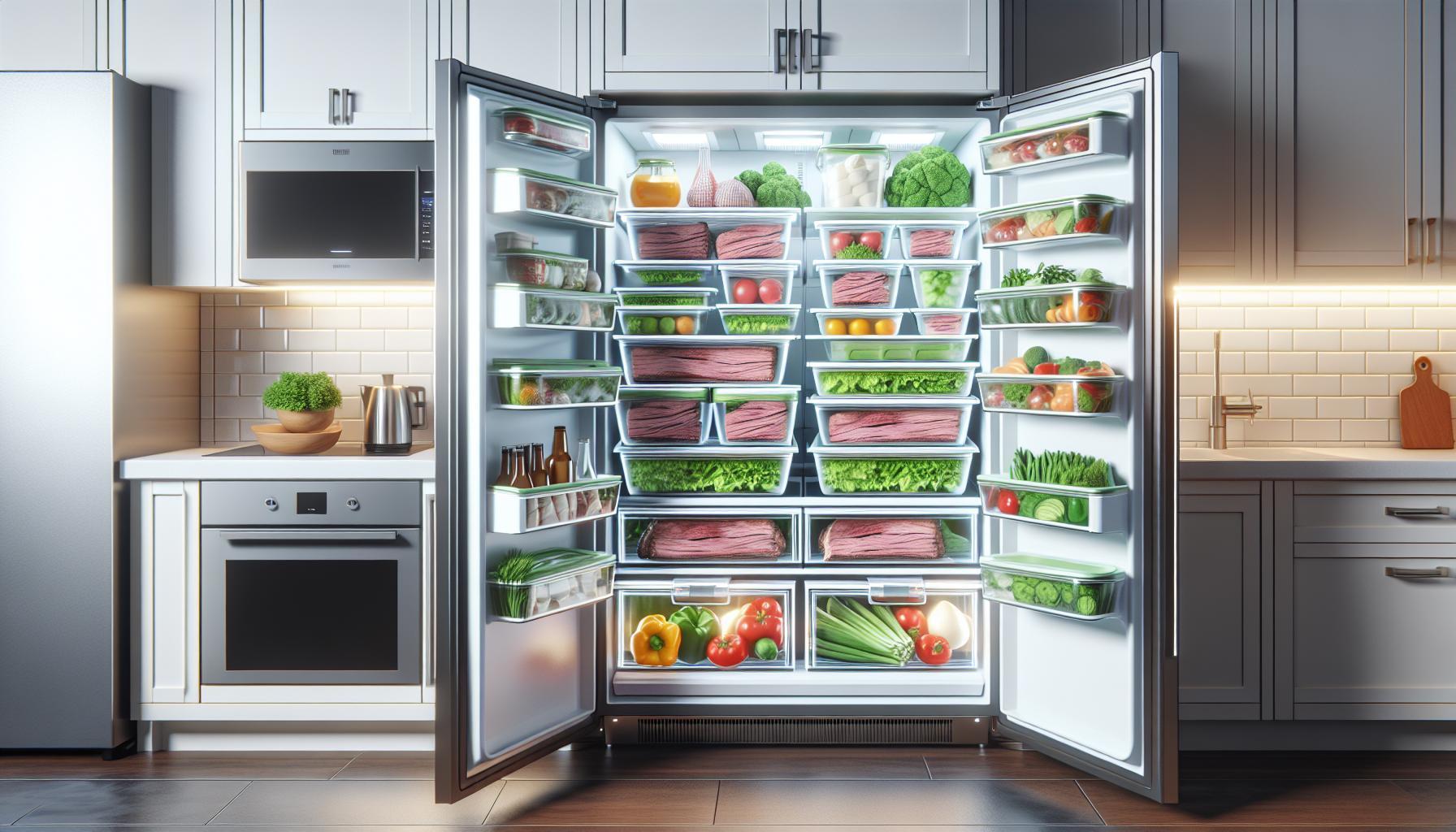When it comes to holiday feasts and special occasions, spiral ham is often the star of the table. This flavorful option can elevate any meal, but many people wonder: how long does a spiral ham last in the fridge? Knowing the safe storage times not only helps you enjoy leftovers at their best but also ensures you keep your family’s health a top priority.
A well-stored spiral ham can remain juicy and delicious for days, but without proper awareness, you risk wasting food or compromising safety. By understanding the right storage methods and timeframes, you can savor every last bite while minimizing waste. Whether you’re a cooking novice or a seasoned chef, this guide will equip you with the essential information to keep your spiral ham at its peak freshness. Let’s dive into the details and make sure your next meal is both safe and scrumptious!
How Long Can a Spiral Ham Stay Fresh in the Fridge?
When it comes to enjoying a delicious spiral ham, proper storage is key to maintaining its freshness and flavor. A spiral ham can typically stay fresh in the refrigerator for 3 to 5 days after being opened. If the ham is still in its original packaging and has not been opened, it can last a bit longer, up to 1 week depending on the sell-by date marked on the package.
To ensure your spiral ham stays as fresh as possible, always store it at a temperature below 40°F (4°C). Utilize either the original packaging or wrap it tightly in cling film or aluminum foil to prevent air exposure, which can lead to spoilage. When storing ham, it’s important to keep it away from raw meats and other foods to avoid cross-contamination.
For optimal longevity, consider portioning out any leftovers. This not only makes for easier meals but also helps minimize the number of times the ham is exposed to air, maintaining its moisture and preventing quicker spoilage. Ensure that any leftover portions are consumed within 3 to 5 days, just like the opened ham. And remember, always rely on your senses; if the ham starts to emit an off smell or shows signs of discoloration, it’s best to err on the side of caution and discard it.
Understanding the Best Storage Techniques for Spiral Ham
To keep spiral ham fresh and flavorful, proper storage techniques are essential. This delicious cut of meat can spoil quickly if not stored correctly, impacting both taste and safety. One key step is to ensure the ham is stored at a refrigerator temperature of 40°F (4°C) or lower. By keeping your spiral ham at this temperature, you reduce the risk of bacterial growth and preserve its quality.
When it comes to packaging, utilizing the original vacuum-sealed packaging can be very effective. This method minimizes air exposure, which can lead to dryness and spoilage. If the original packaging has been opened, rewrap the ham tightly in plastic wrap or aluminum foil. It’s also advisable to use an airtight container if you plan to cut into the ham. Wrap small portions separately to limit exposure when you take out slices for meals. This not only maintains moisture but also makes it easier to handle leftovers.
For longer storage, consider freezing the ham. While a spiral ham can last in the fridge for 3 to 5 days after opening, freezing it can extend its life significantly. When doing so, make sure to wrap the ham tightly to prevent freezer burn. Signs of spoilage include off smells, discoloration, or a slimy texture-if you notice any of these changes, it’s best to discard the ham. By following these techniques, you can enjoy your spiral ham with peace of mind, knowing that you’re keeping it fresh and tasty.
Signs That Your Spiral Ham Has Gone Bad
To ensure you enjoy your spiral ham to its fullest, it’s essential to recognize the signs of spoilage. Even if it was perfectly fine just a few days ago, improper storage or extended time can lead to unwanted changes. Understanding these signs not only helps prevent food waste but also safeguards your health.
The first indicator of spoilage is an unpleasant odor. Fresh spiral ham typically has a mild, savory smell, while spoiled ham may emit a sour or rancid odor. Trust your senses; if the ham no longer smells appetizing, it’s time to discard it. Discoloration is another red flag. Fresh ham should have a consistent, rosy color. If you notice gray or green spots, especially combined with other signs of spoilage, it’s best to err on the side of caution and throw it away.
Texture is crucial, too. A good spiral ham should be moist and firm, whereas a slimy or sticky texture can indicate bacterial growth. Before using any portion of the ham, feel it; if it seems excessively slippery, it’s no longer safe to consume. Paying attention to these details will allow you to enjoy your spiral ham without worry. Always remember, when in doubt, throw it out-it’s better to lose a little ham than to risk a foodborne illness.
How to Keep Spiral Ham Moist and Flavorful
To maintain the juiciness and flavor of your spiral ham, several key practices can make a significant difference. One of the most effective methods involves using moisture-retaining techniques while storing and reheating. When refrigerating your leftover ham, ensure it is tightly wrapped in aluminum foil or plastic wrap. This not only helps to lock in moisture but also prevents the ham from absorbing any strong odors from other foods in your fridge.
Another vital tip is to incorporate a glaze or a marinade before storing or reheating. Many cooks enjoy using a honey or brown sugar glaze, which can help enhance the flavor and keep the surface moist. To apply, brush the glaze liberally over the surface of the ham before wrapping it for storage. This not only adds flavor but also aids in moisture retention.
When it comes time to reheat your spiral ham, consider using an oven at a low temperature (around 325°F or 160°C) to gently warm it. Place the ham in a roasting pan, adding a splash of broth or water to the bottom and covering it with foil. This creates steam, which further ensures moisture is maintained. Heat it just until warmed through, typically not exceeding 15 to 20 minutes per pound to avoid drying out the meat.
Incorporating these strategies will help anyone keep their spiral ham moist and flavorful, allowing for a delicious dining experience long after the initial cooking. Always remember, careful preparation and proper reheating techniques can turn leftover spiral ham into a succulent delight rather than a dry disappointment.
Does Freezing Spiral Ham Extend Its Shelf Life?
Freezing spiral ham is an effective strategy to extend its shelf life significantly. When properly frozen, spiral ham can maintain its best quality for up to six months. This means if you find yourself with leftover ham after a holiday feast or meal prep, you can safely store it away for future use without worrying about spoilage. However, to maximize the quality, it is essential to follow proper freezing and packaging techniques.
Before freezing, it’s vital to ensure that the ham is adequately wrapped to prevent freezer burn, which can impact both flavor and texture. Wrap the ham tightly in plastic wrap, followed by a layer of aluminum foil, or place it in an airtight freezer bag. For added security, consider using a vacuum sealer, which removes air and can further preserve the quality of the meat. Label the packaging with the date to keep track of how long it’s been stored.
Another consideration is whether to freeze the ham whole or in slices. Slicing the ham before freezing can facilitate easier portioning later on, allowing you to thaw only what you need. To thaw your spiral ham, it’s best to move it from the freezer to the refrigerator at least 24 hours before you plan to eat it. This gradual thawing helps retain moisture, keeping your ham juicy and flavorful.
When it comes to reheating, be sure to follow safe practices as well. Reheat the ham slowly in the oven to ensure even warming and to avoid drying it out. Adding a splash of broth or glaze can help keep the meat moist, ensuring that your frozen treat tastes just as good as when it was first cooked.
The Importance of Proper Packaging for Spiral Ham
Ensuring that your spiral ham stays fresh and flavorful hinges significantly on how well it is packaged. Proper packaging not only preserves the quality of the ham but also prevents bacterial contamination and freezer burn, which can compromise its taste and texture. Did you know that improper packaging can lead your ham to spoil much more quickly, even in the refrigerator? Understanding the importance of effective packaging techniques is essential for maintaining the integrity of your ham, especially if you plan to store it for an extended period.
To safeguard your spiral ham, start by using the right materials. The best practice is to wrap the ham tightly in plastic wrap to create a barrier against air exposure. This initial layer should then be followed by aluminum foil or placed in an airtight freezer bag. This multi-layer method is vital, as it provides added protection against moisture loss and prevents the formation of harmful ice crystals that can occur during freezing. For those looking for maximum freshness, consider utilizing a vacuum sealer. This device eliminates air entirely, significantly extending the ham’s shelf life by limiting oxidation and moisture exposure.
Labeling your packages is another critical step that often gets overlooked. Clearly mark the date on your packaging so you can easily track how long the ham has been stored. Spiral ham typically lasts about 3 to 5 days in the refrigerator if properly packaged. However, if you choose to freeze it, you can extend its shelf life up to six months-provided it’s been packaged correctly. Regularly check your stored ham to ensure that the packaging remains intact, and if you see any signs of wear, it’s best to rewrap it to maintain freshness.
In summary, whether for short-term or long-term storage, the way you package your spiral ham plays a pivotal role in its longevity and quality. Taking these simple, yet effective steps not only helps keep your ham juicy and flavorful but also promotes food safety, allowing you to enjoy your culinary creations without worry.
Can You Reheat Spiral Ham Without Drying It Out?
Reheating spiral ham while retaining its moisture and flavor is a culinary challenge that many face, especially after a festive occasion. The key to successfully warming this delicious meat lies in a method that prevents overcooking and drying out, ensuring you can delight in every juicy bite.
Start by slicing the ham into smaller pieces, if not already pre-sliced. This allows for more even heating, as the smaller portions warm up faster and absorb flavors more effectively. Preheat your oven to 325°F (160°C). Place the slices in a baking dish, and to combat potential dryness, cover them with aluminum foil. Adding a splash of broth, apple juice, or a glaze made of honey and mustard can enhance the moisture content and add a delightful kick of flavor. The moisture from these liquids will create steam, which helps keep the ham succulent.
Bake the ham for about 10-15 minutes per pound, checking frequently to ensure it doesn’t overcook. A meat thermometer is useful here; you should aim for a temperature of around 140°F (60°C) for reheating. Once warmed, let the ham rest for a few minutes before serving-this allows the juices to redistribute throughout the meat, enhancing the juiciness.
Additionally, microwave heating is an option for convenience, although it’s less effective for preserving moisture. If you choose this method, place the ham in a microwave-safe dish with a little broth or water, cover it, and heat in 30-second intervals, checking to prevent overheating.
In summary, reheating spiral ham can be simple and satisfying if done correctly. By focusing on the right temperature, using liquids to maintain moisture, and allowing time for the meat to rest, you can enjoy a flavorful, juicy spiral ham any time after its initial preparation.
Creative Ways to Use Leftover Spiral Ham
Leftover spiral ham is not just a delightful memory of your last feast; it’s a canvas for a variety of delicious meals. With its smoky flavor and tender texture, this type of ham can elevate countless dishes. Instead of letting those scraps linger in your fridge, consider some creative culinary uses that keep your meals exciting and minimize waste.
One fantastic way to use up leftover spiral ham is by incorporating it into a hearty soup or stew. Simply chop the ham into bite-sized pieces and add it to a pot of simmering vegetables, beans, and broth. The diced ham adds a rich, savory depth to the broth, enhancing the overall flavor. You can also make a comforting split pea soup or a classic ham and potato chowder-both of which are perfect for chilly nights and can be stored in the fridge for several days.
Another exciting option is to transform your ham into a savory breakfast staple. Dice the ham and mix it into scrambled eggs or omelets for a protein-packed start to your day. Alternatively, make a delightful breakfast casserole by layering cubed bread, shredded cheese, and diced ham, all enveloped in a creamy egg mixture. Bake until golden and set; this dish is perfect for family gatherings or meal prepping for the week.
If you’re in the mood for something lighter, spiral ham can also be the star of a refreshing salad. Combine diced ham with crisp greens, fresh fruits like apples or pears, and a sprinkle of nuts for crunch. Drizzle with a tangy vinaigrette to enhance the flavor further. This not only brings a satisfying crunch but also a balance of textures and tastes that make for a delightful lunch or light dinner.
Finally, don’t overlook the possibilities of sandwiches! A classic ham sandwich can be elevated with unique spreads, artisan breads, and add-ons like avocado or roasted vegetables. Consider crafting a warm ham and cheese sandwich, or even a ham and pineapple panini, mixing sweet and savory flavors that make each bite unforgettable.
With these ideas, you can not only enjoy your leftover spiral ham but also create culinary delights that keep your dining experience fresh and exciting. Each meal reflects the versatility and flavor of this beloved dish, proving that leftovers can indeed turn into something extraordinary.
Safety Tips for Storing Cooked and Uncooked Ham
Ensuring the safety of your spiral ham, whether cooked or uncooked, is crucial to maintaining both quality and health standards. This ham type, beloved for its flavor and convenience, can harbor bacteria if not stored correctly, which can lead to foodborne illness. When storing your spiral ham, pay attention to a few key practices to keep it safe and delicious.
First and foremost, always store spiral ham in the refrigerator if you’re not consuming it immediately. Cooked spiral ham can last in the fridge for up to 3 to 4 days, while uncooked ham is good for about 5 to 7 days. To maximize freshness, wrap it tightly in plastic wrap or aluminum foil, or keep it in a well-sealed container. This prevents exposure to air and moisture, helping to maintain the ham’s quality and flavor.
Temperature Matters
Keep your refrigerator set at or below 40°F (4°C). A thermometer can help you check the temperature regularly. When transporting ham from the grocery store or a cooked ham from a gathering, aim to refrigerate it as soon as possible-preferably within two hours of cooking or purchase. If the ambient temperature is 90°F (32°C) or higher, refrigerate within one hour to prevent bacterial growth.
Another safety tip is to utilize the freezer for long-term storage. If you won’t be consuming the spiral ham within the recommended fridge timeframe, it’s safe to freeze it. Wrap it securely in freezer-safe materials, ensuring that you remove as much air as possible to prevent freezer burn. Properly stored, frozen cooked spiral ham can last for up to 3 months without significant loss of quality. For uncooked ham, you can extend this period to about 6 to 12 months.
Following these simple guidelines, you can avoid common mistakes in ham storage and enjoy your spiral ham safely, whether it’s fresh from the store or leftover from a festive meal. Always be vigilant for signs of spoilage-such as an off smell, slimy texture, or discoloration-and when in doubt, it’s best to err on the side of caution and discard any questionable ham.
Comparison: Spiral Ham vs. Other Types of Ham
Spiral ham is a favored choice among holiday feasts and family gatherings due to its unique preparation and flavor profile. Its distinctive spiral-cut design allows for easy serving and enhances its presentation on the dinner table. When comparing spiral ham to other types of ham, such as whole hams, boneless hams, or country hams, several factors come into play, particularly regarding storage, taste, and cooking methods.
One key difference lies in the shelf life of various ham types. Cooked spiral ham typically lasts in the refrigerator for about 3 to 4 days, whereas a whole cooked ham can remain fresh for up to a week, given that it is properly stored. Uncooked spiral ham should be consumed within 5 to 7 days, similar to its whole uncooked counterpart, but frozen storage amplifies this advantage, allowing spiral hams to be frozen for up to 12 months without significant loss in quality. Understanding these timelines can help consumers make informed decisions on which ham type best suits their needs, especially during busy holiday seasons.
When it comes to flavor and texture, spiral ham stands out for its moistness and tenderness due to the gradual cooking method it often undergoes, coupled with its glaze. Comparatively, country hams, which are salt-cured and dry, provide a more intense flavor, but tend to be saltier and firmer in texture. This difference is pivotal for consumers who prioritize taste versus a more succulent and tender meat. Users may prefer spiral ham for sandwiches or ideal holiday meals, while others may choose country ham for its robust flavor profile in appetizers or gourmet dishes.
It’s also important to consider preparation and cooking methods when choosing between spiral ham and other types. Spiral ham is usually fully cooked, requiring only reheating, which complements the busy schedules of home cooks. In contrast, other ham types, such as fresh or partially cured hams, demand additional cooking time and preparation steps, making them less convenient for a hassle-free meal. The ease of serving spiral ham, combined with its flavorful glaze, reinforces its popularity for gatherings where time and satisfaction are paramount.
By evaluating these differences, consumers can better understand how to store, serve, and enjoy their chosen ham type, ensuring safety and maximizing flavor in each bite.
Common Mistakes in Storing Spiral Ham
Storing spiral ham correctly is essential for retaining its flavor and moisture, but many people make common mistakes that can lead to spoilage or dry meat. One prevalent error is improper refrigeration. Spiral ham should always be stored in the coldest part of the refrigerator, ideally at or below 40°F (4°C). Leaving it in the door or at the back might not provide a consistent temperature, leading to quicker deterioration. Make sure to consume cooked spiral ham within 3 to 4 days for optimal safety and taste. For uncooked spiral ham, aim to use it within 5 to 7 days.
Another frequent mistake is not properly covering the ham. Exposure to air can lead to drying out and loss of flavor. Wrapping the ham tightly in plastic wrap or aluminum foil is crucial. If the ham comes with a glaze packet, ensure that it’s also stored correctly in the refrigerator and used within its designated timeframe. Additionally, many people fail to check the best-by dates on the packaging, which can signal when the ham should be consumed or frozen.
Moreover, underestimating the importance of proper thawing can negatively impact quality. If you’re thawing a frozen spiral ham, do so in the refrigerator rather than at room temperature; this prevents the growth of harmful bacteria. It’s important to allow sufficient time for thawing-generally, it takes about 24 hours for every 4 to 5 pounds of ham.
Finally, consider the way you handle leftover spiral ham. Many individuals overlook the necessity of quickly refrigerating leftover portions. Ensure that any remaining ham is stored in an airtight container within two hours of serving. Storing leftovers promptly not only preserves their quality but also reduces the risk of foodborne illnesses. By being mindful of these common storage pitfalls, you can enjoy your spiral ham juicy, flavorful, and safe for the entire family.
Faq
Q: How long can cooked spiral ham be stored in the fridge?
A: Cooked spiral ham can last for 3 to 5 days in the fridge when properly stored. Ensure it is refrigerated within two hours after cooking to maintain its quality and safety.
Q: Can spiral ham be left out overnight?
A: No, spiral ham should not be left out overnight at room temperature. Bacteria can multiply rapidly at temperatures above 40°F, so it’s important to refrigerate it promptly.
Q: What is the best way to store leftover spiral ham?
A: The best way to store leftover spiral ham is by tightly wrapping it in foil or plastic wrap, or placing it in an airtight container. This helps prevent dryness and maintains flavor.
Q: How do I know if spiral ham is still good to eat?
A: Check for signs of spoilage, such as an off smell, sticky texture, or discoloration. If it exhibits any of these signs, it is safer to discard it.
Q: Should I thaw frozen spiral ham in the fridge or at room temperature?
A: Always thaw frozen spiral ham in the fridge, not at room temperature. This prevents bacterial growth and ensures the ham stays safe to eat.
Q: How can I reheat spiral ham without drying it out?
A: To reheat spiral ham without drying it out, wrap it in foil and add a splash of broth or water before placing it in the oven at a low temperature.
Q: Is it safe to eat spiral ham after the sell-by date?
A: Yes, spiral ham can still be safe to eat after the sell-by date if it has been stored properly in the fridge. Always inspect it for spoilage before consuming.
Q: How long can I freeze spiral ham for later use?
A: Spiral ham can be frozen for up to 6 months. For best quality, wrap it tightly in freezer-safe packaging and label it with the date.
In Retrospect
To keep your spiral ham juicy and safe, remember that it typically lasts 3 to 5 days in the fridge once it’s been opened, with proper storage in an airtight container. If you’re concerned about freshness, consider using a meat thermometer to check for safe serving temperatures. Don’t forget to explore our practical guides on food storage tips or dive into our article on the best ways to reheat ham without drying it out. As you continue your culinary journey, sign up for our newsletter to receive more expert insights and delicious recipes straight to your inbox. Share your experiences in the comments below, and let us know how you keep your leftovers tasty! By taking these steps, you ensure not just safety, but also a delightful meal every time.





